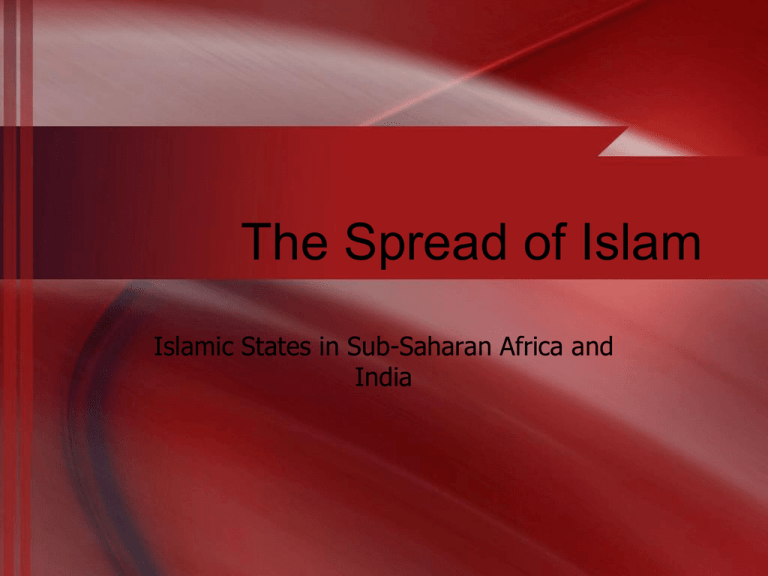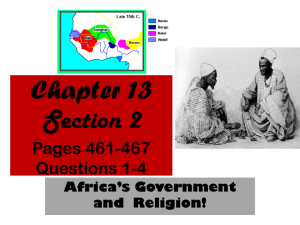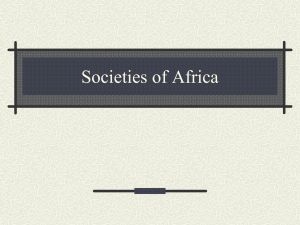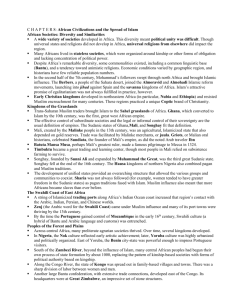The Spread of Islam Islamic States in Sub-Saharan Africa and India
advertisement

The Spread of Islam Islamic States in Sub-Saharan Africa and India Spread of Islam • In the centuries after its birth, Islam spread quickly – Refer back to chapter 8 on Islam for refresher • Trade and peaceful interaction helped to spread Islamic faith to Sub-Saharan Africa – Regional states in Africa thrived on TransSaharan trade and adopted Islam • Although less peaceful, Islam also spread to India African Societies • Huge Continent (See Overhead map of Africa) – Sparsely populated relative to size – Unification of culture difficult due to geography – Regions develop at different rates • Some develop large, complex societies while others remain foragers • Much of the continent lies in the Tropics – Near equator (b/t Tropic of Capricorn and Tropic of Cancer) – Diverse climates due to wind patterns, altitude, and landforms http://planetsave.com/files/2007/12/800px-world-map-torrid.svg-thumb.png Tropics African Societies • Although there is a great degree of diversity among the cultures of Africa, some commonalities can be observed – Language: Bantu Migrations (ch. 7) provide lang. base for many African groups • Each with local variation, but similar structure – Religion: animistic, belief in witchcraft and evil spirits, veneration of ancestors – Govt: Stateless societies common • Governed by council from the community • As time passed, external pressures from other groups created a need for larger, organized states – Trade major motivator • Trans-Saharan trade conducted by Muslims Islam Beyond the Sahara • By 700, Islam dominated North Africa – Trade along caravan routes across the Sahara encouraged the spread of Islam further south • Regional Kingdoms emerged to take advantage of the trade – Ghana, Mali, Songhay – Served as “middle men” between the Muslims and the African communities further south and in the interior http://www.nps.gov/history/ethnography/ aah/aaheritage/images/AfricaComposite. gif Ghana • Founded in W. Africa during 3rd Century – Dev. Of gold and saltbased economy • At height of power in 900’s • Evetually, Ghana converts to Islam • Went into decline in 1200’s – Vulnerable to attack from those seeking wealth • Other states rose up to take Ghana’s place http://faculty.umf.maine.edu/~walters/web%20230/map%2 0african%20empires.gif – Refer to Chapter 7 for more on Ghana Mali • Founded by Muslims who broke from Ghana – Build economy based upon trade and ag. – Mali assumes power position after decline of Ghana • Creates much larger state • See map on page 331 for size and location of Mali Mali – Emphasis on trade • Harsh penalties for those who disrupt trade routes – Highly organized society • Each clan assigned specific occupations for efficiency – Gold and copper make Mali a very wealthy kingdom Mali • Mansa Musa (1312-1337) – Famous ruler, made pilgrimage to Mecca in 1324 • Opportunity to show Mali’s wealth to the rest of the world – Floods markets with so much gold, its value declines – Returns from Pilgrimage with Muslims architects and scholars • Timbuktu became a center for Islamic learning and art – Mosques – Construct Quranic schools to study Islam Mali • Mali began to disintegrate after 2 centuries – Lack of strong leadership in latter rulers – Rebellions by conquered peoples – Attacks from those seeking wealth • As was the case with Ghana, Mali will then be replaced by another kingdom Songhay • Farmers, herders, and fishers in the Niger Valley began to organize a state in 7th century – 1010: est. capital at Gao • Ruled by Muslims, but much of the populace retains tribal religion – Attempts at instituting Shar’ia difficult b/c many people in empire were still non-Mulsim • Gao grew into a wealthy city as a result of gold • Sunni Ali forged the Songhay Empire in the 1400’s – Empire continues to expand into the mid-1500’s Swahili Coast of East Africa • Islam also thrived on Africa’s east coast – Swahili Coast • Trading centers where Muslims engaged in trade along Indian Ocean • Diverse peoples on the Swahili Coast – Bantu and Swahili-speaking peoples governed by Muslim elites – Swahili most common language • Major cities emerge on coast • Location made travel on monsoon winds easy • access to gold from Great Zimbabwe, a powerful state in Southern Africa near the Zambezi River Slave Trade • Although the spread of Islam brought wealth to Africa, it also led to an increase in the slave trade • Slavery had existed in pre-Islamic Africa, but Muslim rule led to a drastic increase in the trade – Estimates of up to 4.8 million slaves transported along Muslim Caravans from Africa – Slaves fulfilled many tasks from household labor to serving as concubines in harems • Slavery was usually not hereditary, leading to a constant demand for more slaves New Delhi Sultanate • After fall of the Gupta, India fragmented into regional kingdoms – Invaders took advantage of lack of political unity – Set up government in Delhi • Recognized by the Muslim Caliph http://countryturkmenistan.tripod.com/index.blog/1160667/indoturkmenistan-relations-and-the-formation-of-cultural-heritage-of-turkmenistan-in-middleages/DelhiSultanateMap.jpg Delhi Sultanate • Sultans in India often ruled with brutality – Maintained rule through fear • Violent raids, looting, forcing Indian women into harems – Instituted high taxes • Min-14th Century, Sultanate in decline and new states rose up Impact of Islam in India • Introduction of papermaking in India • Urdu: new language – Combination of Persian and Hindi written in Arabic characters • Islam became second most popular religion in India – Buddhism largely pushed out • Muslims burn Buddhist manuscripts and terrorize monks • Patriarchy still firmly in place, but evidence suggests that the condition of women saw some improvement – “Sati”- widows burning themselves on their husband’s funeral pyre became less common



